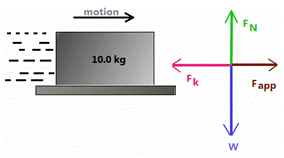Back to: PHYSICS SS1
Welcome to class!
In today’s class, we will be talking about friction. Enjoy the class!
Friction

Introduction to friction
When we throw a ball on the floor it starts moving with some velocity. But once it is rolled ideally no force is acting in the direction of motion and according to Newton’s first law the ball should keep on rolling but this does not happen. The ball stops after moving a certain distance so a force must be acting on it. That force is known as friction.
What is friction?
When a solid object moves or attempts to move over the surface of another solid object its motion is always opposed by a retarding force. This force is called friction. Thus, friction is the force-directed opposite to the direction of motion or attempted motion. The frictional force is always parallel to the surface in contact.
Types of friction
Static friction:
The friction force that comes into play between the two surfaces when one body tends to move on the surface of the other body is called static friction.
The maximum value of static friction is called limiting friction. Example: sliding of a book or a box over the ground.

Static/Stationary Friction
µs = = ———————————— (1)
N:B
(i) R = w= mg
(ii)Fr = Fm
Fr = µs mg —————————————– (2)
Mg sin
Fr
wcos = mg cos
Static/Stationary Friction
Fm = mg sin ——————————————- (3)
R = w = mg cos ————————————————- (4)
µs = = = tan ———————————– (5)
Fm = moving force
Fr = limiting frictional force
Fn = force applied
R = Normal reaction between surfaces
W = Weight,
µs = Coefficient of Static/Stationary friction.
NB:
(i) Fm = minimum parallel force to the plane required to just slide the object
(II) = angle of friction
Kinetic friction:
The frictional force that comes into play between the two surfaces when one body moves on the surface of the other body is called kinetic friction.
Where F1 is the dynamic friction,
R is the normal reaction between surfaces and µk is the coefficient of kinetic friction.
NB: F1 = Fm
Where Fm x s = ½ mv2
There are two types of kinetic friction. They are:
(a) Sliding friction
The friction that exists between two surfaces when one body is sliding on the other is called sliding friction. For example friction between the woodblock and the road when the woodblock slides on the road.
(b) Rolling friction
The friction that exists between two surfaces when one surface is rolling over the other is called rolling friction. For example friction between the tyre of moving vehicle and the road.
Factors affecting friction
- Nature of surface: If there is more roughness, more is the friction. if the surface of an object is smooth, less friction is produced.
- Weight (normal force): If the weight of an object is more, then friction is more and if the weight is less, friction is also less.
- The surface area in contact: The larger the surface area of contact the more the friction. This means that the more the interlocking the more the friction.
Advantages (applications) of friction
- Friction between pen and paper enables us to write on the paper.
- It enables us to hold a pen.
- Friction between our feet and the ground allows our movements like standing, walking and running.
- It holds the screw in wood.
- It allows dishes to stand on the table & many more.
- Friction between the surface of the road and tyres of our vehicles allow the vehicles to move without slipping
Disadvantages of friction
- Friction produces heat, but some of the energy is wasted in overcoming friction.
- It causes wear and tear of the sole of shoes. For example, the sole of our shoes wears out after prolonged use because of friction with the rough road surface.
- The heat produced by friction damage rubber parts of the machine.
- Friction causes moving objects to stop or slow down.
Reduction of friction
Methods to reduce friction are as follows-
- In some situations, friction is undesirable. We need to reduce it.
- In the engines of vehicles, use of lubricants increases the efficiency as parts are not rubbed directly each other because of a thin layer of lubricant.
- In many machines, graphite powder, oil, grease are used as a lubricant for reducing friction.
- Few drops of oil are poured on the hinges of a door for reducing friction, the door moves smoothly.
- While playing carom, sprinkle the fine powder over it to reduce friction.
- With the help of lubricant, we can reduce friction. Lubricants make a thin layer over the surface and facilitate smooth movement.

Laws of friction
- The frictional force opposes the relative motion of two surfaces.
- The frictional force is parallel to the surfaces in contact.
- The frictional force is directly proportional to the normal reaction.
- The frictional force is independent of the area of contact.
- The frictional force depends upon the nature of the two surfaces in contact and their state of roughness.
- The kinetic friction is independent of the relative velocities of the surfaces.
In our next class, we will be talking about Position, Distance and Displacement. We hope you enjoyed the class.
Should you have any further question, feel free to ask in the comment section below and trust us to respond as soon as possible.

I love this class
friction formula is confusing
I enjoy most of this class